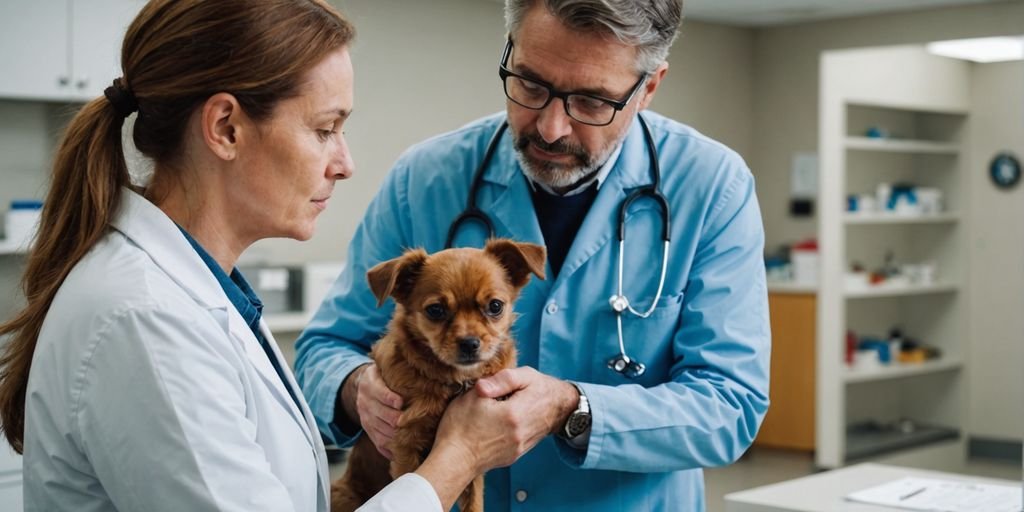Pets bring joy and love into our lives, but emergencies can happen at any moment. Knowing what to do in these critical situations can make a world of difference. This article will cover the top five pet emergencies every owner should be prepared for.
Key Takeaways
- Always have the contact information of a 24-hour emergency vet clinic readily available.
- Recognize the signs of breathing difficulty and act quickly to get your pet the help they need.
- Severe blood loss is a critical emergency; apply pressure to the wound and seek immediate veterinary care.
- If you suspect your pet has ingested poison, contact a vet or poison control center immediately.
- During a seizure, keep your pet safe by removing nearby objects and seek veterinary help as soon as the seizure ends.
1. Breathing Difficulty

Breathing problems in pets can be alarming and require immediate attention. If you suspect your furry friend is experiencing breathing difficulties, it is best to seek veterinary care as soon as possible. Certain dog breeds, especially those with brachycephalic (squished face) features like Bulldogs and Pugs, are more prone to these issues. However, any pet can face breathing problems due to various reasons such as exercise, allergies, foreign objects, heat stress, or underlying lung and heart conditions.
Symptoms of Breathing Difficulties
Look out for the following signs that may indicate your pet is having trouble breathing:
- Bluish gums or tongue (lack of oxygen)
- Coughing or sneezing
- Discharge from the nose or eyes
- Excessive panting
- Open-mouth breathing
- Rapid or labored breathing
Immediate Actions to Take
If you notice any of these symptoms, follow these steps:
- Stay Calm: Your pet will sense your anxiety, so try to remain as calm as possible.
- Ensure Safety: Move your pet to a safe and quiet location.
- Contact a Veterinarian: Call your vet or the nearest emergency clinic immediately.
- Follow Instructions: Follow any guidance provided by the veterinary professionals.
Quick action can make a significant difference in the outcome for your pet. Always err on the side of caution and seek professional help if you are unsure.
Remember, breathing difficulties are a serious issue and should not be ignored. Timely intervention can save your pet’s life.
2. Severe Blood Loss
Severe blood loss in pets is a critical emergency that requires immediate attention. If bleeding is severe or lasts more than five minutes, it must be checked by a vet. The fur could be hiding a bigger problem, or the animal might need stitches to heal without infection. The cut could be deeper than it appears, or there could be internal bleeding that needs surgery.
Signs of Severe Blood Loss
- Panting excessively
- Dark or bright red gums
- Dry tongue
- Staggering, stupor, or seizures
- Bloody diarrhea and/or vomiting
Immediate Actions to Take
- Apply pressure to the wound using a clean cloth or bandage.
- Keep the pet calm and still to prevent further blood loss.
- Transport the pet to the nearest veterinary clinic as quickly as possible.
For severe bleeding, emergency surgery may be necessary to get the blood loss stopped. Once your dog is stable, the work of determining a cause begins.
Preventive Measures
- Regularly check your pet for any signs of injury.
- Keep sharp objects and hazardous materials out of reach.
- Ensure your pet’s environment is safe and free from potential dangers.
3. Ingestion of Poison

Pets can accidentally consume harmful substances, leading to severe health issues. Immediate action is crucial if you suspect your pet has ingested a toxin.
Common Household Toxins
Pets can encounter various toxins in a typical household, including:
- Cleaners and chemicals
- Chocolate
- Fertilizers
- Flowers and plants
- Grapes
- Medications (prescription and over-the-counter)
- Pesticides
- Rodenticides
- Xylitol (also known as birch sugar)
Symptoms of Poisoning
Signs that your pet may have ingested a poison include:
- Vomiting and diarrhea
- Lethargy
- Seizures
- Loss of consciousness
Immediate Steps to Take
- Stay Calm: Panicking can make the situation worse.
- Remove Access: Ensure your pet cannot consume more of the toxin.
- Contact a Vet: Call your veterinarian or an emergency animal hospital immediately.
- Call Poison Control: The ASPCA Animal Poison Control Center (APCC) is available 24/7 at 888-426-4435.
- Follow Instructions: Do not induce vomiting unless instructed by a professional.
Quick intervention can save your pet’s life. Always have the contact information for your vet and a poison control center readily available.
Prevention Tips
- Store chemicals and medications out of reach.
- Keep an eye on your pet during walks to avoid antifreeze and other street toxins.
- Educate yourself on plants and foods that are toxic to pets.
By being vigilant and prepared, you can protect your pet from the dangers of poisoning.
4. Seizures

Seizures in pets can be a frightening experience for any owner. They often occur suddenly and may present as involuntary muscle contractions, loss of consciousness, and drooling. Immediate veterinary attention is crucial to ensure the safety and well-being of your pet.
Recognizing Seizures
Common signs of seizures in pets include:
- Staggering or unsteady walking
- Rapid eye movement
- Jerking or stiffening of the limbs
- Excessive drooling
What to Do During a Seizure
- Stay calm and ensure your pet is in a safe area away from any objects that could cause injury.
- Do not try to restrain your pet or put anything in their mouth.
- Time the seizure if possible, as this information can be helpful for your veterinarian.
- After the seizure ends, keep your pet calm and contact your veterinarian immediately.
Treatment Options
There are currently four main medications used to suppress seizures in dogs in the United States: phenobarbital, potassium bromide, levetiracetam, and zonisamide. Your veterinarian will determine the best course of action based on your pet’s specific needs.
Seizures indicate a problem with the brain and require immediate veterinary attention. Always consult your veterinarian for the best care plan for your pet.
5. Trauma

Trauma is one of the most visible and urgent pet emergencies. It can result from various incidents such as car accidents, falls, or fights with other animals. Immediate veterinary attention is crucial to prevent further complications.
Recognizing Trauma
Signs of trauma can include:
- Visible wounds or bleeding
- Limping or inability to move a limb
- Swelling or bruising
- Signs of pain such as whining or yelping
First Aid Steps
- Stay Calm: Your pet can sense your anxiety, which can make them more stressed.
- Assess the Situation: Check for visible injuries and try to keep your pet still.
- Control Bleeding: Apply gentle pressure with a clean cloth to any bleeding wounds.
- Immobilize Injuries: If you suspect a broken bone, try to keep the limb as still as possible.
- Seek Veterinary Care: Transport your pet to the nearest emergency vet immediately.
Preparedness can save your pet’s life during critical situations. Having a pet first aid kit and knowing emergency contact numbers is essential.
Preventing Trauma
While accidents can happen, there are steps you can take to minimize the risk:
- Keep your pet on a leash during walks.
- Ensure your yard is secure to prevent escapes.
- Supervise interactions with other animals.
- Pet-proof your home to remove hazards.
Recognizing and responding to trauma quickly can make a significant difference in your pet’s recovery. Always err on the side of caution and consult your veterinarian if you suspect any serious injury.
Trauma can deeply affect your pet’s well-being, leading to long-term health issues if not addressed. It’s crucial to recognize the signs early and seek professional help. For more tips on how to care for your pet, visit our website.
Conclusion
Pet emergencies are always stressful, but being prepared can make a big difference. Knowing the common emergencies and how to respond can help you stay calm and act quickly. Always keep your vet’s contact information handy and know the fastest route to the nearest emergency animal hospital. Regularly review first aid procedures and ensure you have a basic first aid kit for your pet. By staying informed and prepared, you can help ensure your pet gets the care they need when it matters most.
Frequently Asked Questions
What should I do if my pet is having trouble breathing?
If your pet is struggling to breathe, stay calm and try to keep them calm too. Contact your vet or an emergency animal clinic immediately and follow their advice.
How can I tell if my pet is losing too much blood?
If your pet is bleeding heavily or the bleeding doesn’t stop after a few minutes, it’s an emergency. Apply gentle pressure to the wound and get to a vet right away.
What should I do if my pet eats something poisonous?
Call your vet or an emergency animal clinic immediately. Have the packaging of the substance if possible and follow their instructions.
What are the signs of a seizure in pets?
Signs of a seizure include uncontrollable shaking, drooling, and loss of consciousness. Keep your pet safe from harming themselves and call your vet.
How do I handle a pet that has been in an accident?
Move your pet carefully to avoid further injury. Contact your vet or an emergency clinic and follow their directions for immediate care.
Can I give first aid to my pet at home?
You can provide basic first aid, like stopping bleeding or performing CPR if trained. However, always seek professional help as soon as possible.
What are common signs that my pet needs emergency care?
Signs include trouble breathing, heavy bleeding, seizures, unconsciousness, and eating something toxic. When in doubt, contact your vet immediately.
How can I prepare for a pet emergency?
Keep your vet’s contact information handy, know the route to the nearest emergency clinic, and have a basic pet first aid kit at home.


